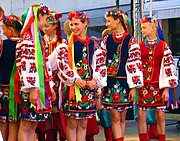From Wikipedia, the free encyclopedia
- This article is about the embroidery style called cross-stitch or counted cross-stitch. For specific crossed stitches used in needlework, see cross stitches.

Cross-stitch is a popular form of counted-thread embroidery in which X-shaped stitches are used to form a picture. Cross-stitch is usually executed on easily countable evenweave fabric. The stitcher counts the threads in each direction so that the stitches are of uniform size and appearance. This form of cross-stitch is also called counted cross-stitch in order to distinguish it from other forms of cross-stitch. Sometimes cross-stitch is done on designs printed on the fabric (stamped cross-stitch); the stitcher simply stitches over the printed pattern.
Contents[hide] |
[edit] History

Cross-stitch is one of the oldest forms of embroidery and can be found all over the world.[1] Many folk museums show examples of clothing decorated with cross-stitch, especially from continental Europe and Asia.
Two-dimensional (unshaded) cross-stitch in floral and geometric patterns, usually worked in black and red cotton floss on linen, is characteristic of folk embroidery in Eastern and Central Europe.[2]
In the United States, the earliest known cross-stitch sampler is currently housed at Pilgrim Hall in Plymouth, Massachusetts.[3] The sampler was created by Loara Standish, the daughter of Captain Myles Standish, circa 1653.
Multicoloured, shaded, painting-like patterns as we know them today are a recent development, deriving from similar shaded patterns of Berlin wool work of the mid-nineteenth century.
Traditionally, cross-stitch was used to embellish items like dishcloths, household linens, and doilies (only a small portion of which would actually be embroidered, such as a border). Although there are many cross-stitchers who still employ it in this fashion, especially in Europe, it is now increasingly popular to simply embroider pieces of fabric and hang them on the wall for decoration.
There are many cross-stitching "guilds" across the United States and Europe which offer classes, collaborate on large projects, stitch for charity, and provide other ways for local cross-stitchers to get to know one another.
Today cotton floss is the most common embroidery thread. It is a thread made of mercerized cotton, composed of six strands that are only loosely twisted together and easily separable. Other materials used are pearl cotton, Danish flower thread, silk and Rayon. Sometimes different wool threads, metallic threads or other speciality threads are used, sometimes for the whole work, sometimes for accents and embellishments.
[edit] Related stitches and forms of embroidery
Other stitches are also often used in cross-stitch, among them ¼, ½, and ¾ stitches and backstitches.
Cross-stitch was often used together with other stitches. It is sometimes used in crewel embroidery, especially in its more modern derivatives. It is also often used in needlepoint.
A specialized historical form of embroidery using cross-stitch is Assisi embroidery.
There are many stitches which are related to cross-stitch and were used in similar ways in earlier times. The best known are Italian cross-stitch, Celtic Cross Stitch, Irish Cross Stitch, long-armed cross-stitch, Ukrainian cross-stitch and Montenegrin stitch. Italian cross-stitch and Montenegrin stitch are reversible, meaning the work looks the same on both sides. These styles have a slightly different look than ordinary cross-stitch. These more difficult stitches are rarely used in mainstream embroidery, but they are still used to recreate historical pieces of embroidery or by the creative and adventurous stitcher.
The double cross-stitch, also known as a Leviathan stitch or Smyrna cross stitch, combines a cross-stitch with an upright cross-stitch.
Berlin wool work and similar petit point stitchery resembles the heavily shaded, opulent styles of cross-stitch, and sometimes also used charted patterns on paper.
Cross-stitch is often combined with other popular forms of embroidery, such as Hardanger embroidery or blackwork embroidery. Cross-stitch may also be combined with other work, such as canvaswork or drawn thread work. Beadwork and other embellishments such as paillettes, charms, small buttons and speciality threads of various kinds may also be used.
[edit] Notes
- ^ Gillow, John, and Bryan Sentance: World Textiles, Bulfinch Press/Little, Brown, 1999, ISBN 0-8212-2621-5, p. 181
- ^ Threads (magazine), Issue 11, June/July 1987
- ^ Loara Standish Sampler
[edit] References
- Caulfield, S.F.A., and B.C. Saward, The Dictionary of Needlework, 1885.
- Enthoven, Jacqueline: The Creative Stitches of Embroidery, Van Norstrand Rheinhold, 1964, ISBN 0-442-22318-8
- Gillow, John, and Bryan Sentance: World Textiles, Bulfinch Press/Little, Brown, 1999, ISBN 0-8212-2621-5
- Reader's Digest, Complete Guide to Needlework. The Reader's Digest Association, Inc. (March 1992). ISBN 0-89577-059-8
[edit] External links
| Wikimedia Commons has media related to: Cross-stitching |
- Cross Stitch A to Z - A Useful A to Z of Cross Stitching
- Counted Cross Stitch Tutorial - Counted Cross Stitch Tutorial.
- Caption Maker - Type in your text and create a chart using various cross stitch fonts.
- Cross Stitch Fabric Tips - Tips on Choosing a Fabric - Includes links to pictures of different samples.
- Celtic Cross Stitch Sample Patterns - Celtic Cross Stitch Sample Patterns.
- The history of embroidery - The history of embroidery.
| |||
| |||




No comments:
Post a Comment